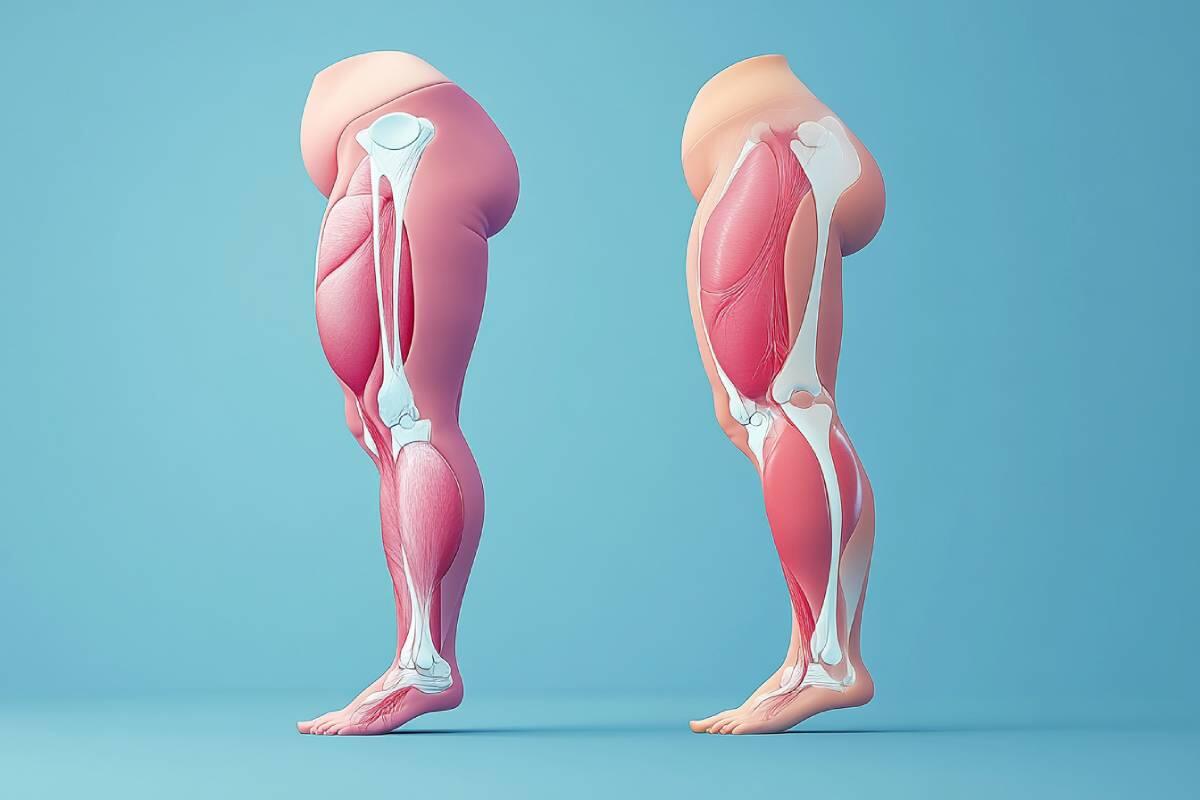How to Know if I Have Lipedema?
Lipedema is a chronic condition characterized by the abnormal accumulation of fat in certain areas of the body, especially in the legs. In some cases, lipedema can also affect the arms, with a clear boundary between the hands and feet (known as the cuff sign).
Women are the most affected, with cases in men being rare. As a consequence, this condition causes inflammation in the body and promotes vascular and lymphatic changes, leading to the accumulation of fluid between cells, known as edema or swelling.
Lipedema was officially recognized as a disease only in 2022. For a long time, it was underdiagnosed and mistaken for obesity, which can still happen. Studies indicate that, although lipedema and obesity can coexist, individuals with normal weight can also be affected.
What Are the Main Symptoms?
More than half of patients report leg discomfort, including generalized pain and increased sensitivity. Additionally, leg swelling and frequent bruising are common symptoms.
📌 Most common symptoms:
✔ Pain and skin sensitivity;
✔ Frequent bruising without apparent cause;
✔ Progressive edema (swelling) that does not improve throughout the day;
✔ Abnormal fat accumulation in the legs, thighs, and, in some cases, arms.
In more advanced cases, excessive fat accumulation can hinder walking, leading to muscle weakness and atrophy.
These symptoms frequently appear during hormonal changes, such as:
✔ Puberty;
✔ Pregnancy;
✔ Menopause.
This factor, along with the higher prevalence of lipedema in women, suggests that sex hormones play a role in the development of the condition. However, the exact cause of lipedema remains unknown. It is believed that there is a genetic component, as 60% of people with lipedema have a family history of the disease.
How Severe Can Lipedema Be?
Lipedema can be classified into five types, depending on the location of fat accumulation, and into four stages, based on structural changes in the skin.
📌 Types of Lipedema:
✔ Type 1: Fat accumulation in the hips and buttocks.
✔ Type 2: Fat accumulation from the hips to the knees.
✔ Type 3: Fat accumulation from the hips to the ankles.
✔ Type 4: Fat accumulation in the arms.
✔ Type 5: Fat accumulation between the knees and ankles.
📌 Stages of Lipedema:
✔ Stage I: Smooth skin with small nodules; reversible edema and occasional pain.
✔ Stage II: Irregular and wrinkled skin with larger nodules; reversible or irreversible edema and thickening of the subcutaneous tissue.
✔ Stage III: Hardened skin with large fat deposits; presence of associated lymphedema.
✔ Stage IV: Lipedema combined with severe lymphedema, causing large volumes of adipose tissue in the legs and arms.
Can People with Lipedema Exercise?
Physical activity is one of the pillars of lipedema treatment. Various types of exercise, such as aquatic exercises and strength training, have been shown to relieve symptoms and improve patients' quality of life.
📌 Recommended exercises for lipedema:
✔ Walking;
✔ Cycling;
✔ Yoga;
✔ Swimming.
Increasing muscle strength is key to reducing fatigue and muscle weakness. Additionally, exercises that activate the legs and calf muscles stimulate lymphatic drainage and venous return, preventing edema.
🔹 Tip: The most important thing is to choose an enjoyable activity to maintain the habit in the long term.
Is There a Cure for Lipedema?
📌 No, lipedema has no cure. However, proper treatment can minimize symptoms and improve the patient's quality of life.
📌 Main treatment strategies:
✔ Balanced diet, with low carbohydrate intake, to control obesity and reduce inflammation.
✔ Regular physical activity, activating the muscle pump to improve venous and lymphatic flow.
✔ Manual lymphatic drainage, providing relief from swelling and pain.
✔ Use of compression garments, such as compression stockings and pneumatic boots.
✔ Psychological therapy, helping with self-esteem and emotional well-being.
Although no single approach is sufficient, the combination of these strategies can provide significant relief for those living with lipedema.
References
🔹 Annunziata, G., Paoli, A., Manzi, V. et al. The Role of Physical Exercise as a Therapeutic Tool to Improve Lipedema: A Consensus Statement from the Italian Society of Motor and Sports Sciences (SISMeS) and the Italian Society of Phlebology (SIF). Curr Obes Rep 13, 667–679 (2024). DOI: 10.1007/s13679-024-00579-8.
🔹 Torre YS, Wadeea R, Rosas V, Herbst KL. Lipedema: Friend and Foe. Horm Mol Biol Clin Investig. 2018 Mar 9;33(1):/j/hmbci.2018.33.issue-1/hmbci-2017-0076/hmbci-2017-0076.xml. DOI: 10.1515/hmbci-2017-0076.
